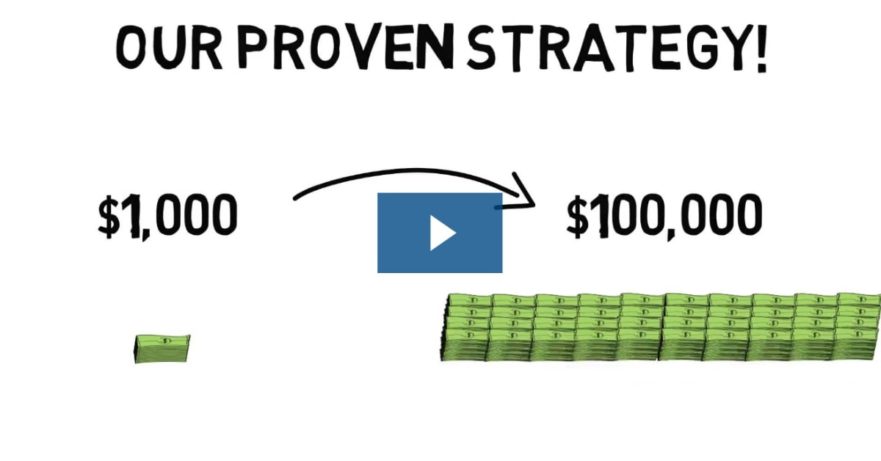This video on compound interest was taken from our course: "The Step-by-step Guide to Your 401k Plan." We hope it's helpful!
*Return information sourced from vanguard.com. The estimated returns of 7% and 9% can be located HERE.
What if I told you that, by investing your money with our proven strategy, you could turn $1,000 into $100,000?
You might not believe me, which would probably be wise of you.
Most people who make such claims are trying to hook you on a get-rich-quick scheme that has no chance of success.
But, believe it or not, there is a proven strategy for investing that yields high returns. It’s not a get-rich-quick scheme; it’s just simple math.
The Snowball Effect: Compound Interest
As shown in the above video, investing is kind of like a rolling snowball.
As the snowball rolls down the hill, it gets bigger and bigger. If the snowball is equivalent to $1,000 and grows 10% each year, at the end of the first year you will have $1,100.
At the end of the second year, you will have $1,210.
Notice that your investment grows by $110 in year 2, not $100 like it does in year 1. In year 2, in addition to your initial $1,000 growing by 10% again, your $100 earnings from last year grew by 10% as well.
After year 3, your investment will have grown to $1,331, an increase of $121.
With time on your side, look at what happens next:
- 20 years later…$6,728
- 30 years later…$17,450
- 40 years later…$45,259
After 50 years of your letting the snowball roll down the hill, your original $1,000 will have grown to over $117,000! Does that seem crazy?
This illustrates the effects of compound interest.
This term simply means “interest earned on interest.”
It really is an “investment snowball effect.” That is our proven strategy: harnessing the snowball effect by maximizing the power of compound interest.
Maximizing Compound Interest
Even though there are no guarantees of what will happen in the stock market, there are three simple ways you can set yourself up for success:
1. Invest as much as you can.
The bigger your snowball at the beginning, the more snow it will pick up on the way.
2. Invest as early as you can.
The earlier you start, the longer you can keep your snowball rolling down the hill.
3. Invest in as much stock as you can.
More stock in your allocation does mean more uncertainty, but also a higher expected return. The higher return is equivalent to making the hill steeper so your snowball rolls faster and picks up more and more snow.
Compound Interest Scenarios
Let’s look at a few hypotheticals:
Suppose your salary is $40,000, and you plan for it to increase by about 2% every year, and you get paid twice a month.
You elect for a fairly conservative asset allocation and receive an average of 7%* return.
Let’s assume you haven’t saved anything for retirement yet, and between you and your employer, you’re saving 10% of your salary each year into your 401(k) plan.
Check out these numbers!
- If you retire in 10 years, you will have $62,770.
- If you retire in 25 years, you will have $324,603.
- If you retire in 40 years, you will have $1,122,013.
Or suppose you’re willing to take on more uncertainty with more stock in your allocation, and you receive an average of 9%* return.
Look at how the numbers change.
- If you retire in 10 years, you will have $118,696.
- If you retire in 25 years, you will have $520,553.
- If you retire in 40 years, you will have $1,730,072.
As you can see, starting to save as early as you can is the key ingredient. However, even if you are not young anymore, all is not lost. You can start now!
No matter how old you are, if you follow the three steps mentioned above, you should see your 401(k) (and other investment accounts) turn into a gigantic snowball!
Next Steps
Need help taking advantage of compound interest? Check out our financial advisor services or give us a call at 1-800-356-7666.
Other Helpful Links
- Learn the difference between stocks, bonds, and mutual funds.
- Check out our video on deciding between roth vs. pre-tax.
- Here is a coupon for 90% off our "Step-by-step Guide to Your 401k Plan."
Securities offered through Triad Advisors, LLC, member FINRA/SIPC. Advisory services offered through Glass Jacobson Investment Advisors, LLC. Glass Jacobson Investment Advisors is not affiliated with Triad Advisors, LLC.
14,900+
Students
120+
Reviews
$99.95 $10
Cost
Should you enroll in your 401k plan? How much should you save? Which investments should you choose? Getting these answers wrong could cost you 100,000's of dollars! Check out our course that will help you come up with a simple plan to reach retirement using your 401k plan.
Get 90% Off Course







